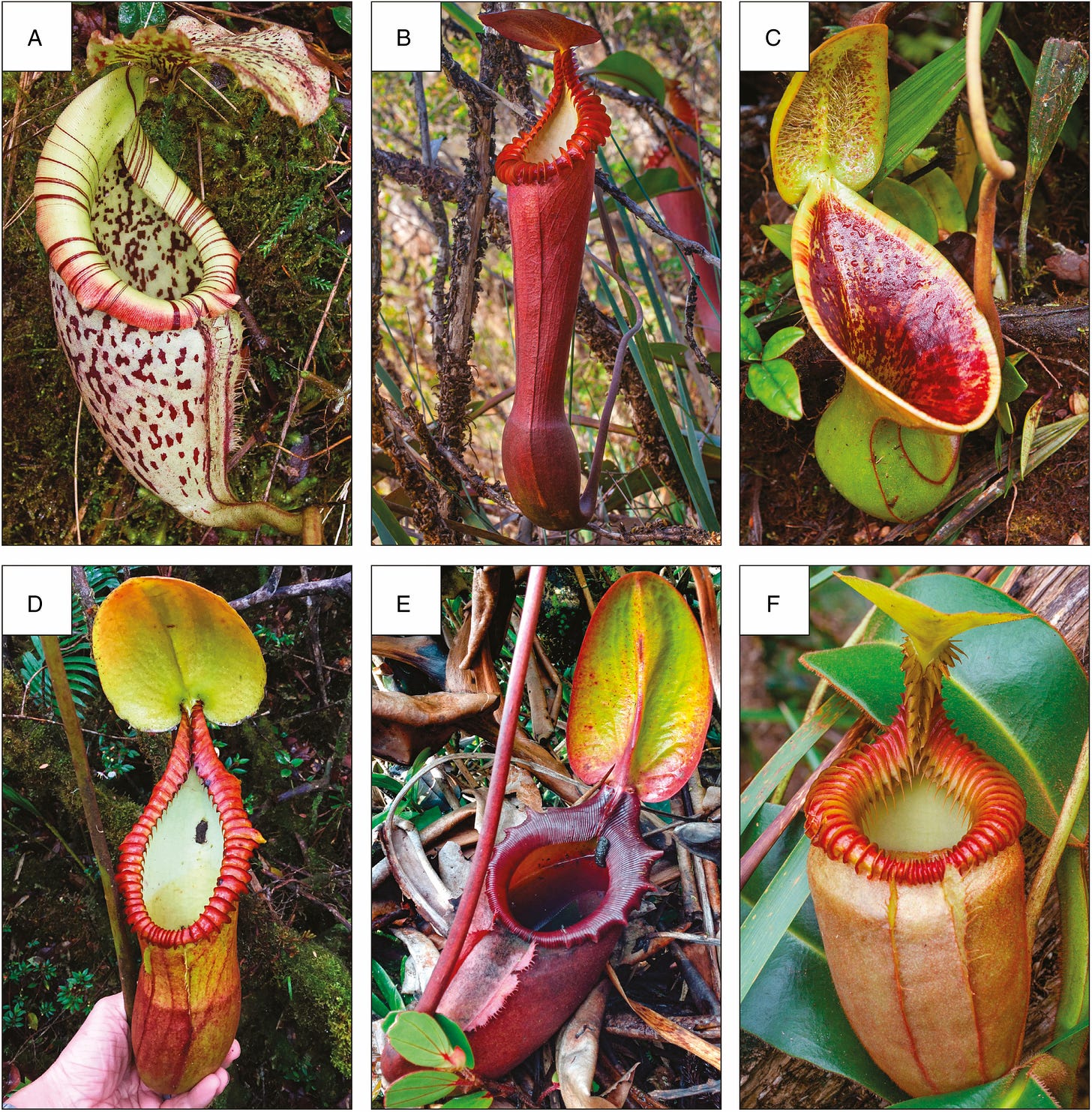Pitcher Plants of Borneo Become Sanitation Engineers
Ex-Carnivorous Plants Have Embarked on a New and Fertile Line of Work
NO AI TRAINING: Without in any way limiting the author’s [and publisher’s] exclusive rights under copyright, any use of this publication to “train” generative artificial intelligence (AI) technologies to generate text is expressly prohibited. The author reserves all rights to license uses of this work for generative AI training and development of machine learning language models.
The lid of the carnivorous pitcher plant has a seemingly obvious purpose: prevent tropical downpours from swamping the vessel beneath, where concentrated digestive juices carry insects on to glory. But just over ten years ago scientists discovered that, in three species found on the island of Borneo, the lid, perplexingly, stands erect.
Scrutiny of the pitcher contents revealed the surprising truth — bait strategically positioned on the upright lid forces tree shrews to spread ‘em over the bowls to reach it. That’s right. These pitchers have evolved to be spectacular, Art Nouveau snack bars/toilets with bar stool(!) pitchers. It’s as if you spied some freshly fried tacos nailed to a wall just behind an open manhole, and you also happened to not be wearing pants.
Pitcher plants (genus Nepenthes) originally evolved to be pitfall traps, botanical Hotel Californias with less exciting views (and lately, better weather). They evolved from leaves, then subsequently sub-evolved into upper and lower pitchers that target flying or crawling insects respectively.
The vessels themselves are eye-poppers. Natural selection has produced designs that wed the costumes of 1930’s Sci-Fi villains with the stylings of Phylum Cnidaria. The result is a spectrum of pitchers in every dress size in shades of lime, maroon, crimson, and cream bedecked with spines, hairs, and fluted rims as sharp as radiator ridges. Nepenthes has clearly decided more is more.

Nectaries that serve as bait may be tucked in strategic locations around the trap. Once bamboozled, the deal is sealed for unwary insects by the lining of the pitcher, which is frequently greased by wax, hairs, glands, and crescent-shaped slippery cells. Several sub-strategies have evolved, including the “lobster-pot” (a constricted opening), “fly-paper traps” (sticky), the bog (jelly-like layer beneath the water in which prey get mired), the lantern (translucent walls of the pitcher glow through an opening on its side, luring in light-attracted insects), and of course, the crapper. One of the three W.C. species — N. lowii — produces pitchers with a distinctive constriction in the middle which really does give them the uncanny appearance of an aerial toilet bowl.
Like many carnivorous plants, pitchers seem to have evolved as a way of fertilizing plants in areas with sunny, wet, acidic, nitrogen-poor soils at high elevation. But as altitude increases, insect diversity and abundance — particularly of ants, pitchers’ favored prey at low altitude — decreases. Enter the need for Plan B, or in this case, Plan #2. It’s easy to imagine how the plants might have evolved in response to mammals raiding what was meant to be insect bait and leaving behind little “presents”, which in this case actually were presents.
Scientists recently decided to investigate how big a contribution the toilet pitchers’ both conventional and unconventional fertilizer makes to pitcher plant nutrition, particularly in comparison with more traditional scuttling and buzzing fare. In an early study of these plants, scientists calculated that somewhere between half and all of the Nepenthes lowii’s leaf nitrogen came from their shrew bar bathrooms.
In the new study, scientists pointed out that ants (pitcher plants’ favorite food at low elevation) are a richer nitrogen source than shrew poo and pee, but what they lack in quality they make up for in quantity and reliability. They calculated that Nepenthes that target animal poop had 1.3 times higher mean total nitrogen than their insect-eating comrades, and almost two-fold higher mean animal-derived nitrogen. It turns out crap is a great fertilizer whether humans or small chittering mammals apply it.
Moreover, tree shrews and occasionally summit rats are not the only mammals to supply pitcher plants with poop on Borneo. Nepehnthes hemsleyana acquires about a third of its leaf nitrogen from the guano of bats that roost inside (hereafter known as bat flats). There is even a bird — the mountain blackeye — that poops in pitchers of N. macrophylla. For some non-obvious reason, no toilet pitchers have ever been found outside the island.
Sadly, there are more Nepenthes at risk of extinction than in any other carnivorous plant genus; 40% of species in the genus are currently classified as “Critically Endangered”. I, for one, don’t want to live on a planet without fancy plant toilets (and Anthropologie wallpaper designers, if the occupied tree shrew loo is not among next season’s designs, I will boycott*). I mean, what are we going to put in the Earth travel brochure, if not this??
*I have never actually bought Anthropologie wallpaper



